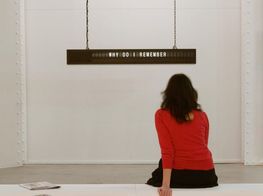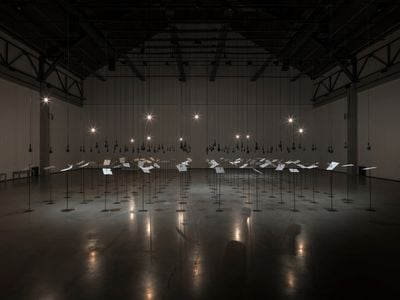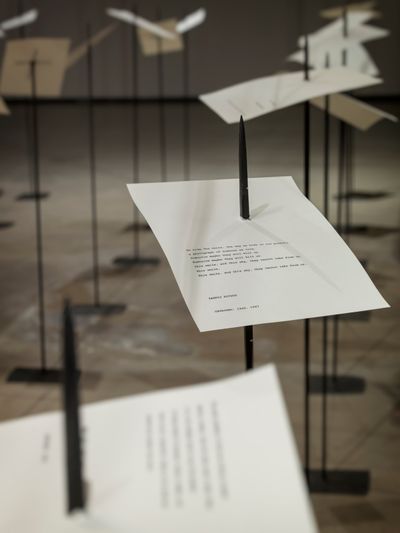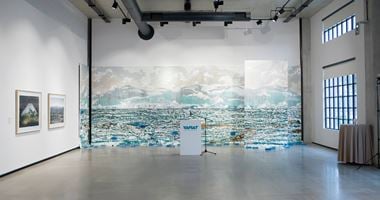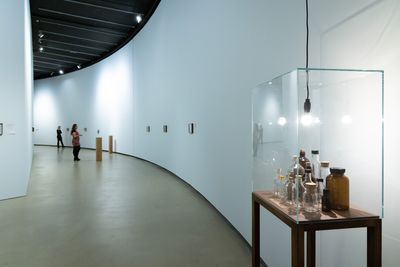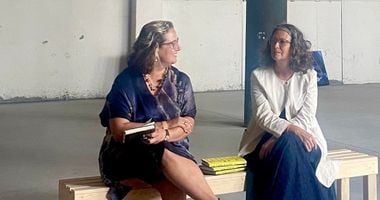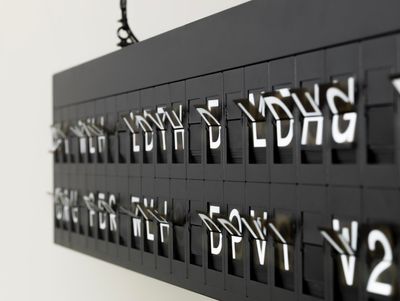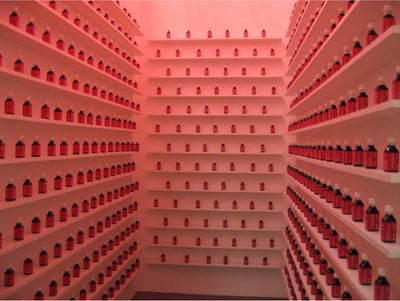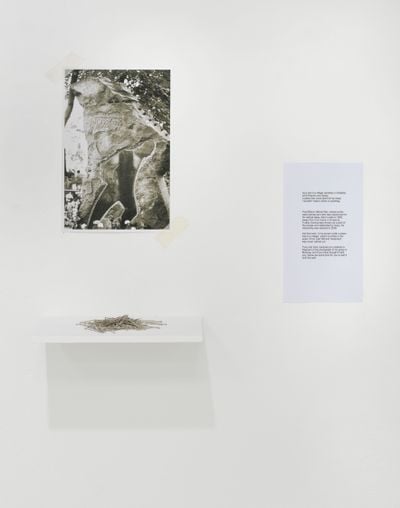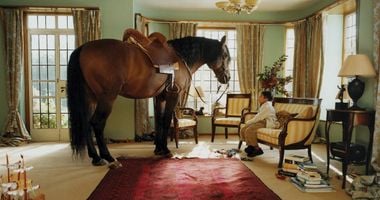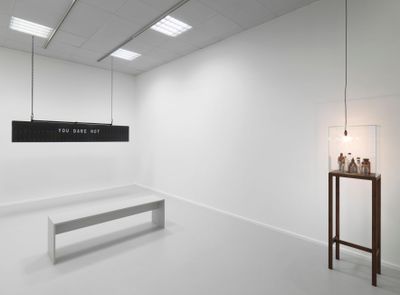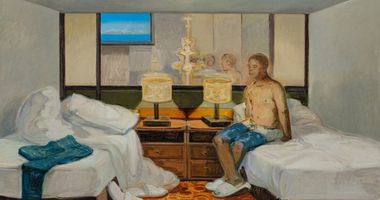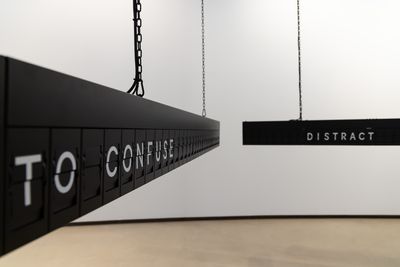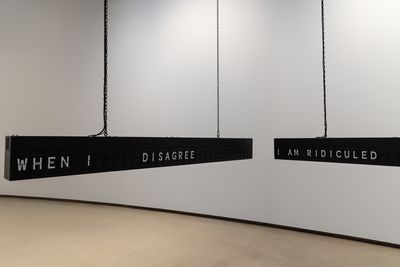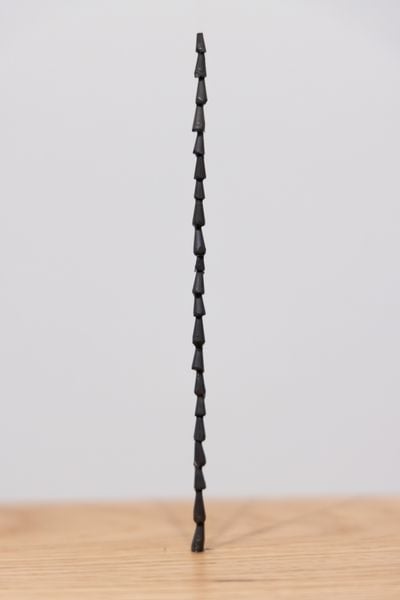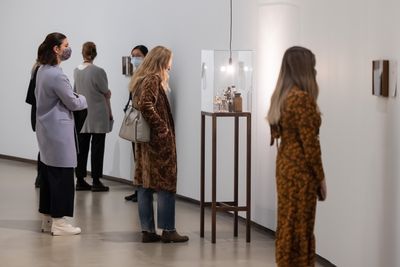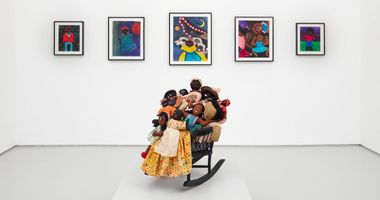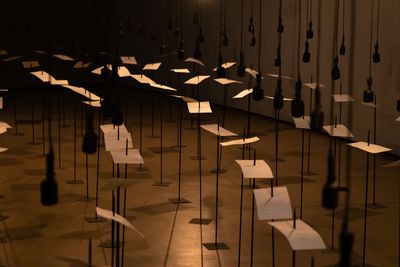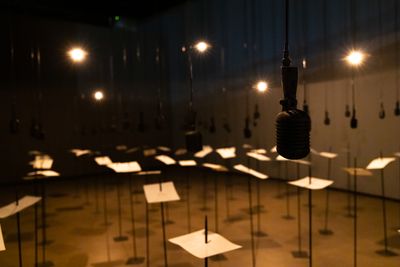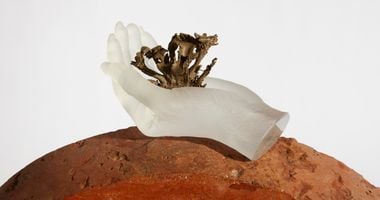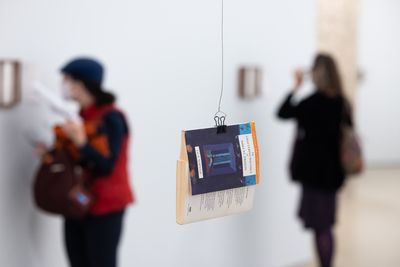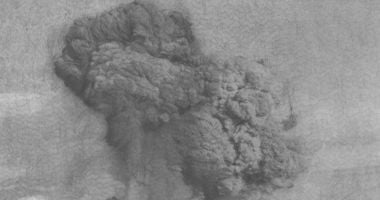Shilpa Gupta's Dialogue of Slowness
Shilpa Gupta. © Shrutti Garg. Photo: Shrutti Garg.
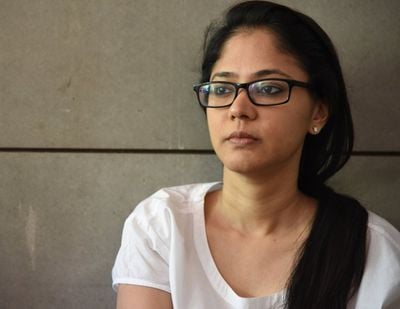
Shilpa Gupta. © Shrutti Garg. Photo: Shrutti Garg.
Anchored in an exploration of erasure and oppression, censorship and surveillance, Shilpa Gupta's art activates lived histories in material compositions that amplify the conditions in which freedom is tested.
The artist's immersive sound installation For, In Your Tongue, I Cannot Fit: 100 Jailed Poets (2017-2018), for instance, honours 100 dissident poets from the 8th century to the present day who were jailed for their art. One hundred microphones are each suspended over a page of their writing, each noting the year of their detention, pierced by a metal rod.
Through these microphones, a chorus of voices speaking in different languages from Hindi to English, to Urdu, Azeri, Russian, and Spanish, sing, hush, and whisper to create an elegiac rhapsody that eventually coalesces into a mesmerising sonic resurrection.
A joint commission between Edinburgh Art Festival (EAF) and YARAT Contemporary Art Space in Baku, the installation takes its title from 14th century Azerbaijani poet, Seyid Imadeddin Nesimi, who was executed for the religious beliefs expressed in his poetry.
'We can't hear ourselves, no one hears us', reads a poignant line from Soviet Osip Mandelstam's satirical poem The Stalin Epigram (1933). The poem's first version, however, did not come from the poet's own hand, as he only ever recited it, but from notes given to the NKVD police, followed by a 1935 hearing after which Mandelstam was taken to the Gulag.
Other poems referenced in the installation engage with human rights, access to democracy, and questions surrounding the formation of political borders. The youngest contribution dates from 2016 when Burmese poet Maung Saungkha falsely claimed to have tattooed Myanmar's president on his manhood.
For, In Your Tongue, I Cannot Fit is a subtle rallying call for free speech worldwide: next to its inaugural presentations in Baku and Edinburgh, and its recent debut in America as part of Gupta's eponymous exhibition at Dallas Contemporary (26 September 2021–13 February 2022), the immersive sound installation was also shown at the 58th Venice Biennale in 2019, and the Kochi-Muziris Biennale in 2018.
Currently, the installation forms a component of Gupta's Sun At Night survey at the Barbican in London (7 October 2021–6 February 2022), which is taking place concurrently to a solo show at Frith Street Gallery, where the kinetic sculpture, Untitled (2021), show a river stone and a light bulb engaging in a mesmerising pas-de-deux.
Showing alongside the work at the Barbican are a series of sculptural objects, which reflects on the lives of the poets Gupta references, including Visitor Hours (2021), which is made from metal, a material selected for its associations with violence. A pie-shaped sector indicating a one-hour-long section of a clock, beginning at 3.00 pm, meditates on perceptions of time, as experienced by those admitted to hospitals and prisons, with limited visitation rights.
Gupta has long sought to engage audiences with her sculptural compositions. The flapboards in Words Come From Ears (2018), currently on view at Gupta's Showroom presentation at Neuer Berliner Kunstverein (n.b.k.) in Berlin (15 September 2021–21 January 2022), display poetic messages instead of train times or flight numbers. Programmed with mistakes, typos, inversions, or omissions—such as 'YOUDETAINME / B6T FOR OTHERS TO FEAR YOU'—they require audiences to fill in the missing letters or values.
As with all of Gupta's work, nothing seems to have a definite end. Rather, Gupta revels in the overlapping or overspilling of themes, titles, and topics—as demonstrated by Today Will End, her first mid-career survey at Museum van Hedendaagse Kunst (M HKA) in Antwerp (21 May–12 September 2021).
The survey featured 30 of Gupta's key works beginning with the mail-art project Untitled (1995-1996) from her art school days at the Sir J. J. School of Art in Mumbai, when she anonymously posted 300 delicate ink drawings to randomly selected recipients from a mailing list at a local art gallery. Later works included Singing Cloud (2008-2009), an installation of 4,000 microphones shaped into a hovering amorphous swarm and emitting an indescribably jumbled sound of individuals speaking at once.
Gupta's intricate investigations also probe geographical borderlands. For, Untitled (There Is No Border Here) (2005–2006), Gupta made a yellow hazard flag out of several layers of self-adhesive tape with the inscription 'THERE IS NO BORDER HERE', while 100 Hand drawn maps of my country (2008-ongoing), invited 100 visitors from different parts of the world to draw the outlines of their countries from memory.
Ultimately, Gupta's art functions around the activations of traces that remain ever prevalent in her compositions—an effect that invokes the artist's invitation for patience and presence when it comes to grasping the metaphorical narratives of her interventions.
In the conversation that follows, Gupta talks about the role of titles, archives, and documentation in her work and how her artistic practice oscillates between that of a writer and researcher. Gupta also reveals what's coming up in 2022, including the publication of the book For, In Your Tongue, I Cannot Fit: 100 Jailed Poets.
MLShilpa, this autumn, you have three concurrent institutional solo shows in Berlin, Dallas, and London. Each addresses the physical and ideological boundaries of writers who compromised their freedom of speech for their art.
The shows are not only in dialogue with each other, but the works are also site-sensitive and portable to the ongoing Covid-19 pandemic. How do you look for or happen upon subjects? Is it a conscious? Or do they represent overlapping moments of encounter?
SGI start with my sketches and notes, which are jottings and scribbles from internal and spontaneous moments. These are responses to an emotion, which have varying levels of cognisance.
They could stem from somewhere within and surprise you with their sudden appearance—like an answer to a problem you are aware about but you were unaware that the mind was working on it. Or they could be a recognisable reaction to a text on a page, or a passing image, or even a conversation or an argument.
There have been times when the responses, which seem to arrive from nowhere, reveal their source after finishing a work, leaving one to marvel at the mysteries of the unconscious.
So, I rarely ever go looking for a subject. It is a deep encounter that finds me and then I look back at it again, and once again to see if there is any possibility of moving forward with it.
It was an unusual overlap that the Barbican invited me to show the Jailed Poets sound installation. I was ruminating on sketches of small objects, and we entered a phase of lockdown after lockdown.
MLCould you talk more about the role of archive and documentation in your practice? How do you approach your research and data?
SGWhile one is collecting, archiving, reading, and listening to research material of different registers, it satiates one side of the curious brain, which is full of endless inquiries.
It's like the city one lives in, which is dense and busy, but one finds by-lanes behind closed walls. So when I sit alone, to do, say the final audio-cut composition of the poets, it needs to be in absolute quiet, in the middle of the night with no one around.
It is when there is a state of pure and beautiful detached focus, where the material loses form, and the work comes together. It's almost as if another brain is at work. However, both brains need each other. Over the years they have grown to rely and whisper to each other and learn to live and even enjoy the risk they impose upon the other.
MLYour sculptures, while poetic and conceptual in nature, balance material and tactile qualities. What makes you return to the sculptural form again and again?
SGI prefer to keep a certain amount of tension alive between the object and the maker, which allows for agility and renewal for both parties. This would be different from when the object or rather the power dynamics via structures around it, take over and overcome the maker. I think this agility or 'lightness of being' allows for the qualities you speak of.
I am interested in the interpretations that ensue via the play of agency and power—what to edit, mute and exaggerate and what to remember and recall.
MLIs the materiality of text important to you? Can you approach the text as an aesthetic object?
SGLet's start with the 'voice' in its primal state—a result of the most direct connection with the body, when the tongue interacts with air, and via an extremely fascinating and sophisticated set of movements, can relay most closely what the mind feels and interprets.
Then follows language and text, which rely on intermediaries and tools. We know that some languages have several words to describe something while other languages have less. I wonder if this has any impact on our understanding of how we sense things.
We interpret what we sense but does interpretation impact what we are capable of sensing? Interpretation does of course impact how we transmit. The relay via tools from one human to the other, which had hastened with great fervour with technology. And tools, as we know, come with their own mechanisms and guidebooks.
I am interested in the interpretations that ensue via the play of agency and power—what to edit, mute, and exaggerate, and what to remember and recall. With the nexus of the extreme right, state, and capital, and with trolls, deep fakes, and bots unleashed online and open lynching—truth and justice, as we know, have become the lame ducks of our time.
'Text' which is a carrier of these notions, moves on fractured appendages, more so today than in the near past. In my works, I am interested in the potential of text itself, its slippery nature, and its malleability. So, to reply to your question, when text does not just narrate but reflects about itself, then the answer is possibly yes.
MLYour solo show at the Barbican carries the intriguing title, Sun at Night. Could you tell us more about its origin and the meaning of titles in your work?
SGI rarely adopt new titles for shows or works and they often come from within. For example, 'Sun at Night' borrows from Nepali poet Laxmi Prasad Devkota, whose work is part of the sound installation. This became the title as both the curator Chris Bayley and I were drawn to the multiple elements it evoked—of imagination, hope, resolution, and the many things poetry and art can be about.
The title of the sound installation at Dallas Contemporary and the Barbican, 'For, In Your Tongue, I Cannot Fit', also comes from a poem by 16th-century poet Nesimi, whose work is in the installation.
Often text from a work become titles. Curator Nav Haq titled the M HKA survey show 'Today Will End' after an outdoor lightwork in the show.
I say recent work and leave my work untitled, in which case they often take on the title of a textual element within the work. Untitled (2005-2006) with 'There is No Border Here', which was printed on cellotapes, takes on the name of the text. Or the untitled, interactive video projections called 'Shadow' due to what is visible in the work.
In movement there is hope of possible escape from weight and abuse.
Believe me, this causes a lot of confusion when looking for work folders in my studio hard drive as sometimes even the venue might take on the folder name. The couple of instances when the work gathers a title is when it has been in the making for several years, as with Someone Else (2011) or Altered Inheritances (2014).
In 2652 (2010), the title comes from the number of footsteps I walked between the three holy sites in Jerusalem.
MLYour artistic practice is participatory. You enter a dialogue with the audience and elicit an exchange of energy or ideas through your works. Has this dialogue shifted since the onset of the Covid-19 pandemic?
I'm thinking about your kinetic sculpture showing at Frith Street Gallery in London, here—of a river stone and a light bulb engaged in a mesmerising pas-de-deux. Perhaps, it could be evocative of this new or 'reformed' audience exchange.
SGYou are perhaps right in a way that the long spell of spending all waking hours in the study, in a single room, and the absence of an audience, lead to a peculiar kind of motion or conversation in silence.
At Frith Street, the knife spins by itself and the stone and bulb, light, and river stone enter into a dialogue of slowness.
MLCan you describe your relation to time, temporality, and pace?
SGI understand these elements in conjunction with their passage. In movement there is hope of possible escape from weight and abuse.
MLYour work often also responds to earlier works. Is there anything you are presently working on that returns to previous works?
SGI am working on a book with Salil Tripathi, the ex-chair of the Writers in Prison Committee, PEN. It will have poems from the sound installation, alongside contributions by poets, lawyers, and human rights activists, including Burhan Sonmez, Varavara Rao, Dareen Tatour, Saw Wai, Marilyn Hacker, and Gautam Bhatia amongst others.
It will be released early next year.
MLExhibition-wise, what does 2022 have in store?
SGThe book is an extensive project that will spill into the first few months of 2022. Alongside it, we are looking at experimental ways to share its research material via online platforms like Instagram. Later in the year, a solo show is planned with Tanya Bonakdar Gallery in New York and there are outdoor projects opening in Mumbai, Doha, and Boston. —[O]

